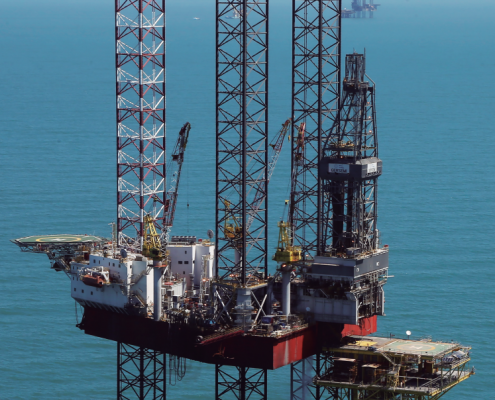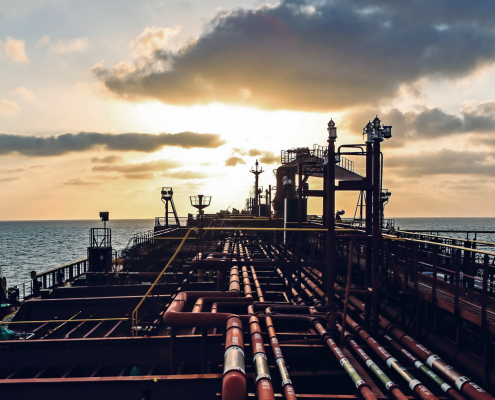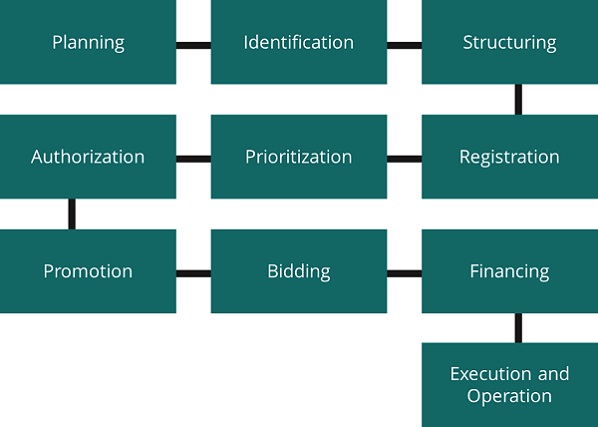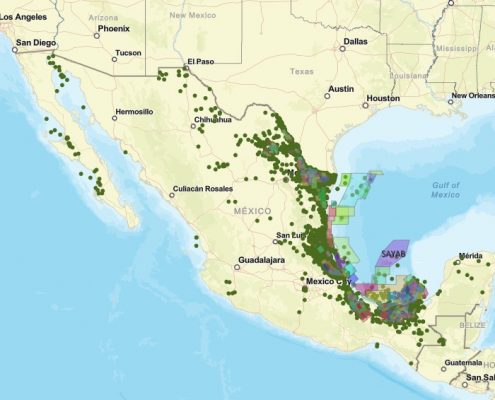Last Review: March, 2025
Banobras offers interested parties information on the sector in Mexico with data from various sources in order to provide knowledge on the subject and useful elements for decision-making at the sectoral level. The content presented does not reflect the position of Banobras.
DECREE issuing the Law of the State Public Enterprise, Federal Electricity Commission; the Law of the State Public Enterprise, Petróleos Mexicanos; the Electricity Sector Law; the Hydrocarbons Sector Law; the Planning and Energy Transition Law; the Biofuels Law; the Geothermal Law; and the Law of the National Energy Commission; amending various provisions of the Mexican Petroleum Fund for Stabilization and Development Law; and amending, adding, and repealing various provisions of the Organic Law of the Federal Public Administration. Consult
DECREE amending, adding, and repealing various provisions of the Hydrocarbons Revenue Law. Consult
Current status
The Secretariat of Energy (SENER), a department of the Centralized Federal Public Administration (APF) in Mexico, has the primary responsibility of establishing, guiding, and coordinating the country’s energy policy, while ensuring compliance, with a focus on energy security and diversification.
Within SENER’s structure is the National Natural Gas Control Center (CENAGAS) as a decentralized agency of the APF.
Among its responsibilities, CENAGAS acts as the independent operator and administrator of the Integrated National System for the Transport and Storage of Natural Gas (SISTRANGAS), with the objective of ensuring continuity and security in service provision nationwide.
The Coordinated Regulatory Organizations* in energy matters hold the status of Federal Executive Branch entities and include the following:
- Energy Regulatory Commission (CRE)
- National Hydrocarbons Commission (CNH)
*On December 20, 2024, the DECREE was published in the Official Gazette of the Federation, amending, adding, and repealing various provisions of the Political Constitution of the United Mexican States, regarding organic simplification. The Congress of the Union will have a period of ninety calendar days from the entry into force to make the necessary adjustments to the relevant laws to comply with it, except as provided in the Tenth Transitory Article.

Source: SENER, Oil platform, Sonda de Campeche, PEMEX
Energy Sector
The Mexican government’s energy policy is guided by the mandate of the 2019-2024 National Development Plan (PND), which establishes the revitalization of the energy sector as a driver of national development. This goal is pursued through the strengthening of Petróleos Mexicanos (PEMEX) and the Federal Electricity Commission (CFE), public entities of the State that enable to ensure the country’s energy security and national security by creating favorable conditions for the realization of its various government programs and projects.
Pemex
On October 31, 2024, a decree was signed through which PEMEX returns to being a Public State-Owned Company. This follows the recent approval of the energy reform by the Chamber of Deputies, the Senate, and the majority of local congresses.
On November 13, the Mexican Government presented the National Strategy for the Hydrocarbons and Natural Gas Sector, which aims to continue the recovery of energy sovereignty, strengthening the planning and organization of the sector, and ensuring strict compliance with national energy policy. The creation of a new fiscal regime for Petróleos Mexicanos (PEMEX) was also announced: the “Petroleum Rights for Well-being,” which will be 30% for oil and 11.63% for non-associated gas.
The strategic lines for the 2024-2030 period include the following:
- The goal is to save 50 billion pesos by eliminating redundant expenses.
- Integration into a single company, strengthening financial stability, and increasing productivity and operational efficiency.
- Commitment to sustainability.
- New exploration techniques will be used in shallow waters of the Gulf of Mexico and land fields in the southeast of the country to maintain, restore, and increase reserves for 10 years of consumption.
- The production of liquid hydrocarbons is expected to remain at a platform of 1.8 million barrels per day, with priority attention to strategic fields such as Zama and Trion.
- The goal is to increase natural gas production to 5 billion cubic feet per day during the current administration.
- Regarding refining, the production of gasoline, diesel, and jet fuel will be increased by 343,000 barrels per day (bpd), representing a 34% increase, to achieve self-sufficiency.
- The refining process at the Deer Park facility will be ramped up to 285,000 bpd, with major maintenance continuing across the National Refining System to generate positive profits from all refineries.
- In terms of logistics, the capacity for storing petroleum products will be increased.
- Strengthening the petrochemical industry through joint projects that guarantee PEMEX’s ownership.
- Efforts will be made to increase the production of ammonia and carbon anhydride for fertilizer production to 2.2 million tons per year.
On January 29, 2025, the Government of Mexico presented the secondary laws of the energy reform, assuring that, with them, the return of Pemex (Petróleos Mexicanos) to the people of Mexico will be established.
The package includes 6 main laws and the harmonization of five others:
- Law on Energy Planning and Transition
- Law of the State Public Company, Federal Electricity Commission
- Law on the Electric Sector
- Law of the State Public Company, Petróleos Mexicanos
- Law on the Hydrocarbons Sector
- Law of the National Energy Commission
With the secondary laws, SENER will resume the authority over binding energy sector planning, which will lead to the enactment of the Energy Planning and Transition Law. Furthermore, this reform eliminates the subsidiaries that were private companies within both organizations (Pemex had three subsidiaries and nearly 50 affiliate companies).
Regarding the hydrocarbons sector, the changes will seek to strengthen Pemex by prioritizing exploration and extraction areas, as well as giving it the option to decide whether to partner with private companies in mixed contracts. Additionally, the traceability of hydrocarbons will be improved, making it mandatory to provide information from the entry of fuels to their distribution at gas stations.
Investment Schemes
Within the investment schemes for exploration and extraction, the traditional Pemex assignment model will be complemented by the possibility of creating mixed development contracts, allowing the company to enhance its capabilities and financing.
PEMEX has achieved stabilization and growth in proven oil and gas reserves, made progress in the rehabilitation of the National Refining System facilities, and undertaken large-scale construction projects to increase crude processing capacity for gasoline, diesel, and jet fuel production. Other achievements include restoring operational conditions in the fertilizer supply chain and gradually recovering the domestic oil products market.
As of the end of 2023, PEMEX reported a net profit of 8,152 million pesos and an EBITDA of 355,473 million pesos.
The revised budget for PEMEX as of June 2024 stands at 408.2 billion pesos, allocated as follows:
- 310.7 billion pesos for oil and gas exploration and production
- 79.4 billion pesos for industrial transformation of refined products, gas, and petrochemicals
- 15.4 billion pesos for logistics
- 2.7 billion pesos for corporate operations.
Hydrocarbons
The hydrocarbon industrial chain comprises three main stages: exploration and production, logistics, and industrial transformation:
Exploration and Production (Upstream)
- Production fields: 261
- Crude oil production: 1,686 thousand barrels per day
- Natural gas production: 4,768 million cubic feet per day
- Average exploration wells: 6,792
- Offshore platforms: 300
Logistics (Midstream)
- Storage and dispatch terminals: 74
- Liquefied gas distribution terminals: 9
- Oil pipelines (km): 7,270
- Multi-product pipelines (km): 8,798
- Fuel oil pipelines (km): 100
- Jet fuel pipelines (km): 66
Industrial Transformation (Downstream)
- Gas processing complexes: 9
- Refineries: 6
- Petrochemical complexes: 6
For more information on the sector, there is the Energy Information System (SIE)* which integrates information in a database fed by the Mexican energy sector agencies, as well as by the Ministry of Energy, responsible for the National Energy Policy. This portal offers the public official statistical information validated by the Energy Sector Units that generate it. Registration is required to enter*.
[1] Sixth Annual Report of the Secretariat of Energy, 2023-2024.
[2] IBID.
[3] PEMEX Statistical Yearbook, 2022.
The National Hydrocarbons Commission makes available to the public the portal of technical information generated throughout Mexico’s oil history:
Institutional Arrangement
In terms of infrastructure, Mexico has a defined strategy that offers investors medium and long-term visibility regarding the development of projects, through a series of plans and programs of national and sectorial scope. To access the information, please consult the following documents:
Energy Sector Program 2020-2024
Five-Year Bidding Plan for Hydrocarbon Exploration and Extraction 2020-2024
PEMEX Business Plan and Subsidiaries 2023-2027
Five-year SISTRANGAS Expansion Plan 2020-2024
Organizational Structure
Description of the hierarchy and roles of the different entities and actors involved in the sector, including how the different institutions and agencies coordinate and collaborate.
The main task of the Ministry of Energy (SENER), an agency of the Federal Public Administration (APF), is to establish, conduct and coordinate the country’s energy policy, in addition to supervising its compliance with priority given to energy security and diversification.
To encourage the achievement of the objectives set in the National Development Plan, this unit establishes strategies and programs, and evaluates their impact within the framework of the Democratic National Planning System and the sectorial programs.
Decentralized organization of the SENER operating as a public research center, dedicated to both research and technological development required by the oil, petrochemical, and chemical industries, providing technical services to them, commercializing technological products and services resulting from research, and training specialized human resources in its areas of activity.
The Mexican Oil Fund for Stabilization and Development is a Public trust managed by the central bank, aligned with the SHCP. This fund receives, administrates, and distributes the revenues, except taxes, that the Federal Government collects from oil and gas exploration and extraction. Additionally, the fund determines the amounts to be paid under existing exploration and extraction contracts, transfers the funds, and invests the remaining resources
The Security, Energy and Environment Agency is a decentralized public entity from the Ministry of Environment and Natural Resources (SEMARNAT), with technical and managerial autonomy, responsible for regulating and supervising industrial and operational safety, as well as the protection of the environment in hydrocarbon related activities.
The ASEA Environmental Gazette is a document that contains information on Environmental Impact Statements (MIA), Preventive Reports (PI) and Unified Procedures that are evaluated by the Industrial Management Unit of the Safety, Energy and Environment Agency (ASEA).
A Coordinated Regulatory Body in energy, responsible for regulating and promoting the efficient development of activities such as the transport, storage, and distribution of hydrocarbons, petroleum products, petrochemicals, bioenergetics, and the generation and supply of electricity. It also fosters industry efficiency, promotes competition within the sector, protects user interests, ensures adequate national coverage, and addresses reliability, stability, and safety in service provision and supply.
This federal public administration regulator with technical autonomy is responsible for auctioning and signing contracts for the exploration and extraction of hydrocarbons, technically managing contract allocations, regulating and supervising surface exploration and hydrocarbon extraction, and developing knowledge and information on Mexico’s subsurface resources.
National Hydrocarbons Information Center (CNIH)
A unit within the National Hydrocarbons Commission, the CNIH is responsible for collecting, managing, analyzing, and publishing information on hydrocarbon exploration and extraction activities within the national territory.
Rondas México
Likewise, the National Hydrocarbons Commission, through the Rondas México portal, discloses all the information related to the technical administration and supervision of the Hydrocarbon Exploration and Extraction Contracts according to the progress of the project.
A decentralized public body under SENER, aiming to ensure the reliable, efficient, and safe supply of natural gas throughout the country. It operates as a technical manager of the Integrated National Natural Gas Transport and Storage System (SISTRANGAS) and provides efficient natural gas transport services.
PEMEX
A productive state-owned company, exclusively owned by the Federal Government, with its own legal standing and assets and enjoys technical, operational, and management autonomy. Its operations cover the entire production chain, from exploration and production to industrial transformation, logistics, and commercialization of hydrocarbons and derivatives.
Subsidiary Productive Companies (EPS) of PEMEX:
Exploration and Production
Focuses on the exploration and extraction of petroleum and hydrocarbon compounds (solid, liquid, or gaseous) within national territory, the country’s exclusive economic zone, and abroad.
Drilling and Services
Provides services for drilling, repairing, and maintaining extraction wells, adhering to standards for quality, timing, cost, safety, health, and environmental protection.
Logistics
Provides hydrocarbon, petroleum, and petrochemical transport and storage services, as well as capacity sales for storage and handling. Manages planning, evaluation, and development of projects and other business initiatives.
Industrial Transformation
Engages in refining, transformation, processing, and commercialization of hydrocarbons, petroleum products, natural gas, and petrochemicals.
Fertilizers
Produces, distributes, and commercializes ammonia, urea, fertilizers, and derivatives, along with related services.
Ethylene
Produces, distributes, and commercializes methane, ethane, and propylene derivatives.
A state-owned public company tasked with generating, transmitting, distributing, commercializing, and supplying primary inputs for the electric industry, as well as auxiliary and related activities. The Federal Government exclusively owns the CFE, which has its own legal standing, assets, and technical, operational, and management autonomy. It is a major participant in gas transportation.
Legal system
The compilation of international treaties, laws, regulations, decrees, agreements and federal, state and municipal provisions shown here are for informational purposes and for ease of reference:
ENERGY
PEMEX

Source: Sixth Work Report, SENER. Vessel Kukulcan, Mexican Pacific, PEMEX.
Investment cycle
The following section provides an overview of the project development process from initial planning to final execution.

Exploration and Production
Based on the objectives and strategies defined in the Five-Year Bidding Plan for the Exploration and Extraction of Hydrocarbons 2020-2024, SENER prepares the short, medium and long term sectorial programs for the development of energy resources in the country.
Transportation and Logistics | Refining
Based on the objectives and strategies defined in the Energy Sector Program (PROSENER), SENER prepares the short, medium and long term sector programs for the development of energy resources in the country.
Exploration and Production
Based on the planning documents, SENER, together with the CNH and PEMEX, identifies the exploration and production projects to be developed.
Transportation and Logistics
Based on the planning documents, SENER together with CENAGAS and PEMEX identifies the transportation projects to be developed.
Refining
Based on the planning documents, SENER together with PEMEX identifies the industrial transformation projects to be developed.
Exploración y Producción
SENER y CNH, con el apoyo técnico de PEMEX Exploración y Producción, elaboran, por su cuenta o con el apoyo de consultores externos, los estudios y análisis necesarios para el desarrollo de los proyectos.
Transporte y Logística
SENER y CRE con el apoyo técnico de PEMEX Logística y CENAGAS elaboran, por su cuenta o con el apoyo de consultores externos, los estudios y análisis necesarios para el desarrollo de los proyectos.
Refinación
SENER, con el apoyo técnico de PEMEX, elabora por su cuenta o con el apoyo de consultores externos, los estudios y análisis necesarios para el desarrollo de los proyectos.
Exploration and Production
The CNH registers the projects to be developed.
Transportation and Logistics
SENER sends to the SHCP’s Investment Unit the request for registration in the portfolio of transportation projects that require resources from the Federal Expenditure Budget.
Refining
SENER sends to the SHCP’s Investment Unit the request for registration in the portfolio of industrial transformation projects that require resources from the Federal Expenditure Budget.
Exploration and Production
Projects requiring federal budgetary resources must be analyzed by the SENER, with technical recommendations from PEMEX and the CNH, which determines the relationship for inclusion in the PEF.
Transportation and Logistics
The CRE has the power to grant and, if applicable, cancel permits and authorizations for the storage, transportation and distribution of oil, natural gas and petroleum products, as well as ethane, propane, butane and naphtha transported exclusively by pipeline.
Refining
Projects requiring federal budgetary resources must be analyzed by the SENER, with technical recommendations from PEMEX, which determines the relationship for their inclusion in the PEF.
Exploration and Production
Both SENER and CNH have the power to grant permits and authorizations for reconnaissance and surface exploration.
Transportation and Logistics
Projects requiring federal budgetary resources must be analyzed by SENER, with the technical recommendations of the CRE and CENAGAS, who determine the relationship for their inclusion in the PEF.
Refining
The SENER has the power to grant permits and authorizations for the industrial transformation of hydrocarbons.
Exploration and Production
In charge of SENER and CNH.
Transportation and Logistics
In charge of SENER and CENAGAS.
Refining
Under the responsibility of SENER.
Exploration and Production
It is in charge of the CNH, following the technical guidelines of the SENER and the fiscal economic conditions established by the SHCP. The terms of reference may be consulted in the CNH’s web page.
Transportation and Logistics
It is in charge of the CRE and CENAGAS, following SENER’s technical guidelines.
Refining
Not applicable, since in industrial transformation matters only agents external to PEMEX participate as investors. In these cases SENER will grant permits either to PEMEX or individuals to carry out oil treatment and refining activities as well as natural gas processing.
Exploration and Production
There are several sources of financing depending on the particular characteristics and financial structuring of each project such as: PEF, commercial banking, developers and institutional and private investors.
Transportation and Logistics
There are different sources of financing depending on the particular characteristics and financial structuring of each project, such as: PEF, commercial banks, developers and institutional and private investors: PEF, commercial banking, developers and institutional and private investors.
Refining
There are different sources of financing depending on the particular characteristics and financial structuring of each project, such as: equity, commercial banks, developers, and institutional and private investors.
Exploration and Production | Transportation and Logistics
Carried out by PEMEX, operators and/or awarded developers, who are supervised by the CNH and SENER according to the terms of the contract.
Refining
Carried out by PEMEX, authorized operators and/or developers, who are supervised by SENER.
Projects
Information on new projects (pre-investment, bidding and execution) and in operation within the Mexico Projects Hub platform, which at some stage of the project were considered investment opportunities and do not necessarily have Banobras / Fonadin participation.
New Projects
Projects in Operation
Banobras / Fonadin
Project Finance: In order to support the financing of infrastructure projects and public services, the Project Finance Unit structures financing supported by the granting of loans and guarantees to those projects developed as Public-Private Partnerships and which have their own source of payment from the exploitation of the concession or public contract or from the collection of the service in question. The Public-Private Partnership schemes may be Federal and/or Local, in their different modalities, such as: Concessions, Service Provision Projects (PPS) or Financed Public Works Contracts, among others.

Financing for States and Municipalities and Decentralized Public Organizations: The products and services are designed to meet the infrastructure needs of states, municipalities and their decentralized public organizations, in order to improve the quality of life of the population and increase competitiveness.
Infrastructure is a pillar of development, which is why Banobras has innovative products and services focused on contributing to regional development through the promotion of financial mechanisms to:
- Boost investment in infrastructure and public services.
- Promote the financial and institutional strengthening of states, municipalities and decentralized public agencies.
To this end, Banobras has the following financing schemes:
Products:
Project Development: Banobras offers services aimed at assisting public sector agencies and entities in the development of infrastructure projects.
Financial structuring of the project:
- Elaborate and/or update studies required by the Public-Private Partnerships Law.
- Support in the review of the bidding conditions and contract model.
- Assist in obtaining financing for the project.
- Assist in the registration process of the project in the portfolio of the Investment Unit of the Ministry of Finance and Public Credit (SHCP).
- Assist in dealing with any observations made by the SHCP Investment Unit.
- Support in the financial closing of the project.
The purpose of the Fondo Nacional de Infraestructura (Fonadin) is to serve as the Federal Public Administration’s coordination vehicle for infrastructure investment. It has one of the largest road concession networks in the world and manages the granting of financial support for infrastructure development, mainly in the areas of communications, transportation, water, environment, energy, tourism, urban and strategic and priority areas, supporting the planning, promotion, construction, conservation, operation and transfer of infrastructure projects with social impact and economic or financial profitability.


It has a wide range of products designed to strengthen the financial structure of the infrastructure projects that the country requires, from the conception to the completion of the projects, providing the following financial instruments that make the projects more attractive for financing with private resources:
Recoverable Support
- Simple Credits
- Subordinated Credits
- Guarantees
- Investments in Venture Capital Funds
- Infrastructure Trust Investments
- Financing of Studies and Advisory Services
Non Recoverable Support
- Contributions for Studies and Consultancy
- Contributions for Projects
- Project Grants
Contact: fonadin.energia@banobras.gob.mx
Sustainability
Banobras makes available to interested parties, analysis sheets for the detection of sustainability practices in infrastructure projects, in accordance with the methodological framework “Attributes and Framework for Sustainable Infrastructure” of the Inter-American Development Bank (IDB). Its objective is to highlight sustainable practices, encourage their adoption in future projects and provide relevant information for investors in their economic, environmental, social and institutional dimensions.
To consult the projects that already have a sustainability record, select the “SEARCH CRITERIA>” option in the PROJECTS section, and then select “With Sustainability Analysis”; the projects that have a record will be displayed below.
In addition, Banobras offers an analysis tool that presents the potential relationship of the different infrastructure projects of the Mexico Projects platform with the 17 Sustainable Development Goals (SDGs) of the 2030 Agenda and their targets. This comparative analysis facilitates the use of data according to different criteria, such as the potential impact of projects and sectors against national and global development goals.
The comparison is only made between projects in the same subsector. To select and consult here.
The alignment of a project with the SDGs provides information on the degree of focus on sustainability; it provides a comparison between projects in the same sector and sub-sector and facilitates investment decisions, showing the highest and lowest alignment of projects to the SDGs. Comparative analysis facilitates the use of data according to different criteria, such as the potential impact of projects and sectors against national and global development goals.
In the case of the sector, 27 projects are identified in the platform that have sustainability practices detection sheets, which allows to know, among other things, the projects with more and better alignments to the SDGs. For more information, access the Sustainable Development Goals application:

Greater alignment of the sector:
- SDG 9: Industry, Innovation, and Infrastructure
- SDG 11: Sustainable Cities and Communities
- SDG 16: Peace, Justice, and Strong Institutions
Lower alignment of the sector:
- SDG 1: No Poverty
- SDG 2: Zero Hunger
- SDG 10: Reduced Inequalities
Ally Networks
Banobras, through its Ally Networks application, provides information on companies participating in competitive public procurement processes for infrastructure projects in Mexico, based on official sources such as CompraNet. It includes details on investment amounts, number of participations in bids, projects awarded, consortiums, and business associations, which allows the user to identify potential actors for the establishment of investments in the country.
To consult the projects that have information on the participating companies, select the option “SEARCH CRITERIA>” in the PROJECTS section, and then select “With applicant companies” at the end of the criteria.
In the application, you can consult on the sector:
- 106 projects
- 197 companies
- 176 consortiums
Reference documents:
This section offers documents, reports and reports with technical, statistical and regulatory information on the sector:
Official statements:
2025
- SENER: Secondary Energy Laws – PEMEX and CFE, Companies of the People of Mexico
- DECREE issuing the Law of the State Public Enterprise, Federal Electricity Commission; the Law of the State Public Enterprise, Petróleos Mexicanos; the Electricity Sector Law; the Hydrocarbons Sector Law; the Planning and Energy Transition Law; the Biofuels Law; the Geothermal Law; and the Law of the National Energy Commission; amending various provisions of the Mexican Petroleum Fund for Stabilization and Development Law; and amending, adding, and repealing various provisions of the Organic Law of the Federal Public Administration.
- DECREE amending, adding, and repealing various provisions of the Hydrocarbons Revenue Law.
- PEMEX: PEMEX presents its work plan 2025-2030
- DOF: Decree amending, adding, and repealing various provisions of the Political Constitution of the United Mexican States, regarding organic simplification.
- Government of Mexico: CFE and PEMEX are once again for the people of Mexico: President signs secondary laws that reverse the 2013 energy reform
- CNH Institutional Strategic Plan 2023-2026
- CRE: Mexican Energy Sector Infrastructure Map.
Additional information:
2024
- Hydrocarbons Law.
- PEMEX: Statistical Yearbook 2023.
- PEMEX: Petroleum Rights for Well-being
- PEMEX: Strategic Lines for the 2024-2030 Period
- PEMEX: Oil statistics August 2024.
- SENER: Permits in force for the production, commercialization and transportation by means other than pipelines of bioenergy products.
- SENER: 2024 Evaluation of the Execution of the Five-Year Hydrocarbon Exploration and Extraction Bidding Plan 2020-2024
- SENER: Five-Year Bidding Plan for the Exploration and Extraction of Hydrocarbons 2020-2024.
- SENER: Sixth Work Report 2023-2024.
- SE: Data Mexico : Oil and Gas Extraction.
- Dos Bocas Refinery




